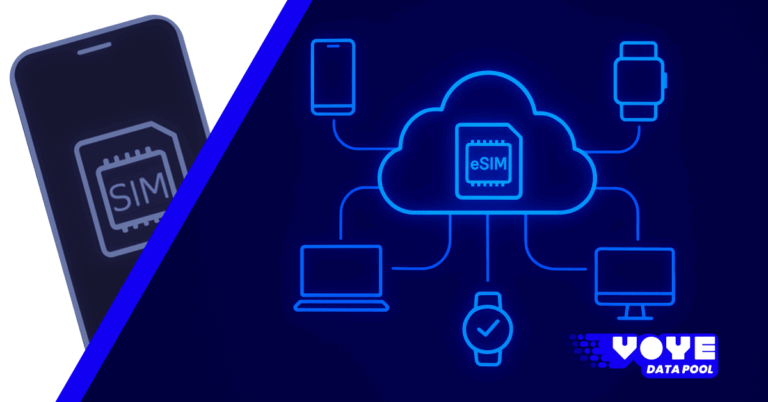Predictable Budgets, Unpredictable Travel: CFO Strategies for Connectivity Control
In today’s borderless business landscape, CFOs face the challenge of managing unpredictable travel costs while maintaining budget predictability. Connectivity has become a critical factor in financial control — yet traditional roaming models fail to deliver consistency. With solutions like Voye Data Pool, CFOs can centralize connectivity, forecast expenses with precision, and gain real-time visibility into data usage across global teams. The result is smarter financial governance and sustainable cost efficiency for a mobile-first enterprise.

The CFO’s New Frontier: Managing Connectivity in a Borderless Business World
In today’s globalized economy, corporate travel is both a necessity and a challenge. Whether it’s executives attending client meetings across continents or sales teams managing operations in emerging markets, connectivity is no longer optional — it’s fundamental. Yet, as essential as it is, it remains one of the most unpredictable line items on a company’s expense sheet.
For Chief Financial Officers (CFOs), this unpredictability translates into a persistent headache: fluctuating roaming costs, inconsistent carrier contracts, and the lack of visibility into mobile data usage across regions. The more international the workforce, the greater the complexity.
As organizations expand globally, CFOs are expected to do more than just manage numbers — they must ensure operational efficiency, enforce cost predictability, and maintain digital readiness. And in an era where travel and communication intersect, connectivity management has quietly become one of the defining challenges of modern financial leadership.
This is where technologies like eSIM data pooling and centralized connectivity control are reshaping how finance leaders approach global mobility budgets.
Why Traditional Connectivity Fails in Today’s Business Landscape
The global enterprise landscape has outgrown traditional telecom models. The once-simple corporate mobile plan has evolved into a complex, multi-layered expense with hidden roaming fees, usage surcharges, and varying service quality depending on the destination.
For traveling teams and remote employees, the options have historically been limited:
- Local SIM cards, which require manual setup, offer inconsistent coverage, and complicate expense management.
- Global roaming packages, which can quickly spiral out of control when travel extends beyond the planned duration or data limits.
- Corporate Wi-Fi and VPN dependencies, which compromise flexibility and productivity when employees are constantly on the move.
CFOs are often left reacting rather than strategizing — reconciling bills after the fact instead of proactively managing costs. Predicting global connectivity expenses in such a model is nearly impossible.
The result? Budgets that fluctuate with every business trip, making forecasting unreliable and eroding financial control.
To move beyond this reactive model, CFOs need solutions that bring visibility, predictability, and control — the three pillars of modern financial oversight in connectivity management.
Enter the Era of Predictable Connectivity: The Role of eSIM Data Pools
eSIM technology has redefined how enterprises approach connectivity. Unlike traditional SIM cards, eSIMs can be remotely activated, reprogrammed, and managed through a single digital platform. This flexibility not only streamlines operations but also enables the creation of shared data pools — centralized connectivity solutions that distribute data usage intelligently across users, teams, or even countries.
A Data Pool, such as the Voye Data Pool, allows companies to purchase a single block of mobile data that can be shared dynamically across multiple employees, regions, and devices. This introduces predictability and eliminates the chaos of managing individual roaming plans.
For CFOs, the advantages are substantial:
- Unified Cost Control:
Instead of fragmented telecom bills from different regions, the finance team manages one centralized account. - Forecastable Expenses:
Monthly or quarterly data pool plans enable CFOs to project accurate communication costs with minimal deviation. - Operational Visibility:
Real-time dashboards show who’s using how much data, from where, and for what — turning connectivity from a “black box” into a transparent metric. - Scalable Efficiency:
As teams expand or travel needs shift, CFOs can scale up or down instantly without renegotiating multiple contracts.
This isn’t just about convenience — it’s a step toward budget predictability, a cornerstone of sound financial governance in a volatile travel environment.

Seamless eSIM Connectivity for Enterprises
Activate, manage, and scale eSIMs with ease.
The CFO’s Dilemma: Unpredictable Travel Meets Predictable Budgets
Every CFO understands that volatility is the enemy of predictability. Yet, when it comes to travel, unpredictability is the rule, not the exception. Global disruptions — from flight delays and border closures to fluctuating data demands — can derail even the most carefully constructed budgets.
The question is not whether travel will remain unpredictable. It’s how CFOs can build systems that absorb that unpredictability without compromising financial discipline.
Connectivity, while often overlooked, is one of the easiest areas to gain that control. Through tools like data pooling and centralized billing, CFOs can introduce a level of predictability into an inherently uncertain operational domain.
When budgets are predictable, planning becomes precise. Expense forecasting becomes reliable. And that level of stability doesn’t just satisfy finance — it empowers the entire organization to travel, communicate, and perform with confidence.
Connectivity Control: A Strategic CFO Priority
Traditionally, connectivity decisions were handled by IT or operations departments. But as costs escalate and digital mobility becomes core to business operations, the CFO’s office must play a central role.
Connectivity now intersects directly with financial efficiency, cybersecurity, and operational resilience — all of which fall under the modern CFO’s strategic purview.
A proactive CFO approach to connectivity involves:
- Standardizing corporate data usage policies across departments and geographies.
- Partnering with global eSIM providers to centralize expense management.
- Implementing data pooling models that align with actual travel and operational needs.
- Integrating usage analytics into financial dashboards for real-time oversight.
This evolution from passive cost center to proactive control mechanism transforms connectivity from an unpredictable liability into a measurable, manageable asset.
Building a Predictable Connectivity Framework
A predictable connectivity framework revolves around three principles — centralization, transparency, and scalability.
1. Centralization
Centralization simplifies complexity. By unifying all connectivity management into one dashboard, CFOs gain visibility into global data usage, costs, and allocations. Platforms like Voye Data Pool consolidate connectivity across teams, allowing CFOs to:
- Set group or department-level data thresholds.
- Adjust usage policies instantly.
- Generate consolidated billing reports without manual reconciliation.
2. Transparency
Transparency creates accountability. With granular reporting, finance teams can identify usage spikes, track roaming behaviors, and enforce compliance. CFOs can now answer questions like:
- Which teams use the most data while traveling?
- Are there regions with excessive roaming charges?
- How efficiently is our shared data pool being utilized?
3. Scalability
Scalability ensures cost predictability as the business evolves. A static telecom plan may serve a startup but fails in a global expansion scenario. A data pool, however, grows with the company — adding new users, devices, and geographies without overhauling the entire structure.
Predictable budgets rely on flexible systems that can adapt as business needs evolve — and that’s precisely what centralized eSIM data pools offer.
The ROI of Connectivity Control: Beyond Cost Savings
While cost reduction is the most visible outcome of centralized connectivity, it’s not the only one. CFOs are increasingly viewing connectivity through a return-on-efficiency (ROE) lens — how operational streamlining drives long-term value creation.
1. Improved Forecast Accuracy
With clear data trends, CFOs can project connectivity costs accurately across fiscal quarters, reducing variance and improving budget credibility.
2. Reduced Administrative Overhead
Automated billing and unified vendor management reduce the time finance teams spend reconciling complex mobile invoices.
3. Enhanced Employee Productivity
Consistent connectivity ensures employees remain operationally efficient, regardless of location — a measurable productivity gain for any enterprise.
4. Strengthened Financial Governance
Data-driven insights allow CFOs to enforce compliance with travel policies and maintain a transparent audit trail for communication expenses.
In short, connectivity control is not just a cost-saving measure — it’s a strategic advantage that enables organizations to operate smarter and scale sustainably.
Real-World Scenario: CFO Challenges in Connectivity
Consider a global consulting firm with employees traveling across Asia, Europe, and North America. Each region relies on a different telecom provider, and the finance team receives separate invoices — in multiple currencies — every month.
The CFO struggles with:
- Unpredictable roaming charges during client site visits.
- Expense reconciliation delays, as employees manually submit data receipts.
- Compliance risks, as some teams use unapproved local SIMs to avoid roaming costs.
By migrating to a centralized eSIM Data Pool, the firm consolidated all connectivity under one global account. Employees received regionally optimized eSIM profiles that auto-connect to local networks, and data usage flowed from a shared corporate pool.
In less than one quarter:
- Monthly telecom costs dropped by 32%.
- Forecast accuracy for travel budgets improved by 47%.
- Administrative overhead related to data expense reconciliation fell by 60%.
This transformation demonstrates how predictable connectivity isn’t a luxury — it’s a financial imperative.
Connectivity Risk Management: A CFO’s Silent Advantage
Connectivity also plays a critical role in risk mitigation. From cybersecurity threats to financial exposure, uncontrolled connectivity introduces a host of vulnerabilities that CFOs must address proactively.
1. Cyber and Data Security Risks
Employees relying on unsecured public Wi-Fi during travel create exposure points for corporate data breaches. Managed eSIM connectivity ensures that all business communication occurs over secure, traceable mobile networks.
2. Financial Exposure
Without centralized control, rogue data usage or overspending on roaming can inflate costs unexpectedly. Predictable connectivity eliminates this financial uncertainty.
3. Compliance Risk
Global enterprises often operate under stringent data regulations. Using authorized, auditable eSIM networks ensures compliance with international telecom and privacy standards.
By adopting a connectivity control strategy, CFOs strengthen not only budget predictability but also enterprise resilience.
CFO Strategies to Implement Predictable Connectivity
To transition from fragmented telecom management to predictable connectivity, CFOs can follow a strategic, phased approach:
- Audit Current Connectivity Costs
Evaluate existing telecom expenses, roaming charges, and contract structures across departments. Identify inefficiencies and redundant plans. - Adopt Centralized eSIM Infrastructure
Partner with a reliable global provider such as Voye Data Pool to implement an enterprise-level eSIM solution. - Implement Data Pool Management Policies
Define allocation limits per region, team, or department, ensuring equitable and efficient use of pooled data. - Integrate with Financial Systems
Sync usage reports and billing data with the company’s ERP or accounting software for real-time expense monitoring. - Train and Transition Teams
Educate employees about new connectivity procedures to ensure smooth adoption and compliance. - Monitor and Optimize Continuously
Use analytics to identify patterns, adjust pool sizes, and refine budget forecasts as global travel evolves.
This framework turns unpredictable telecom spending into a measurable, controllable, and forecastable business function.
Why Voye Data Pool Stands Out
Voye Data Pool is designed for enterprises seeking control, clarity, and cost efficiency in global connectivity.
By leveraging a unified eSIM-based infrastructure, Voye Data Pool empowers CFOs and operations leaders to manage communication budgets predictably, no matter how unpredictable travel becomes.
Key Benefits:
- Coverage in 130+ countries, eliminating the need for multiple local SIMs.
- Real-time management dashboards for cost visibility and usage tracking.
- Flexible data pooling that adapts to team size and travel frequency.
- Instant scalability without long-term contracts or hardware dependencies.
- Enhanced security and compliance, ensuring safe and traceable corporate communication.
For finance leaders seeking budget predictability, operational agility, and full visibility, Voye Data Pool bridges the gap between financial discipline and global mobility.
Looking Ahead: The CFO as a Digital Connectivity Architect
The modern CFO’s role has expanded far beyond balance sheets. Today’s finance leaders are digital architects, designing systems that integrate technology, finance, and operations.
Predictable connectivity — achieved through eSIM and data pooling — is a strategic enabler of this transformation. It aligns with broader corporate goals of digital transformation, sustainable cost management, and employee mobility empowerment.
As the business world becomes increasingly borderless, the ability to manage the unpredictable nature of travel with predictable financial systems will distinguish forward-thinking CFOs from reactive ones.
In the end, the companies that thrive will not be those that travel the most — but those that stay connected, securely and predictably, wherever they go.
Final Thoughts
Budget predictability in a world of unpredictable travel is no longer an impossible goal. With centralized connectivity solutions like Voye Data Pool, CFOs can finally bridge the gap between mobility and financial control.
By transforming connectivity from a cost center into a strategic asset, CFOs gain what they value most: clarity, control, and confidence.
In the unpredictable world of travel, that’s the ultimate competitive advantage.



 10 min read
10 min read





